
Dozens of schools which ‘could be at risk of collapsing’ are ‘told to be ready to shut down at short notice until they can be made safe’
- Hundreds of schools were built with reinforced autoclaved aerated concrete
Dozens of schools that could be at risk of collapsing have reportedly been told they could be forced to shut down at short notice if they are not made safe.
Hundreds of schools across the country were built with reinforced autoclaved aerated concrete, known as RAAC, between the 1960s and 1990s, with the buildings having a life span of around 30 years.
The risk of the ‘crumbly’ concrete, that has previously been likened to a ‘chocolate Aero bar’, has been known for five years now, after a primary school in Kent partially collapsed but now chaos could be caused for thousands of more youngsters.
Pupils face serious injury – or even death – at the hands of such decaying buildings that are long past their shelf-life.
Documents from the Department of Education, seen by The Mirror, reveal that schools affected by the infrastructure need to prepare ‘for the eventuality that they are taken out of use and vacated at short notice’ until they are made safe.
This could see pupils, many of whom have already had their education interrupted by several Covid-19 lockdowns, shipped off to other schools, taught in alternative locations or forced to return to learning remotely online.
Dozens of schools that could be at risk of collapsing have been told they could be forced to shut down at short notice if they are not made safe. Pictured: File photo of primary school class
Hundreds of schools across the country were built with reinforced autoclaved aerated concrete, known as RAAC, between the 1960s and 1990s
School bosses are now being urged to come up with a plan, after being questioned ‘what it would take to implement a plan ahead of the start of term’.
A report by the National Audit Office (NAO) earlier this year revealed that 700,000 children in England attend schools requiring major repairs, with more than a third of buildings being beyond their lifespan.
READ MORE: Watchdog warns 700,000 pupils are attending crumbling schools that put them at risk of injury or death
The watchdog said it would be focusing on the 14,000 schools that were building during the period when RAAC was used in construction.
By May, 65 out of 196 schools inspected were confirmed to have used RAAC. A further 400 were due to be checked out of the 600 potentially affected.
For some schools, the safety warning could mean that some would be preparing for a complete shut down, the paper reports.
Less affected schools could see parts of their buildings, such as individual classrooms or blocks, closed off.
Internal briefings from the Department of Education said: ‘DfE has serious concerns about the integrity of RAAC panels and is committed to supporting responsible bodies to address any safety issues that arise as a result.’
The schools have been ranked by engineers on a scale ranging from ‘High Critical’ – which would require immediate closure – to low.
Internal memos from the department highlight that schools need to have a ‘clear contingency plan’ ahead of the start of term – which starts next week.
A report by the National Audit Office (NAO) earlier this year revealed that 700,000 children in England attend schools requiring major repairs, with more than a third of buildings being beyond their lifespan
Less affected schools could see parts of their buildings, such as individual classrooms or blocks, closed off. Pictured: File photo of students in a lesson
Civil servants have been instructed to call round schools to make sure they have some form of plan in place, including ‘preparations for the eventuality that [schools] are taken out of use and vacated at short notice’.
RAAC deteriorates over time and is prone to sudden failure. This happened at Singlewell Primary School in 2018.
The collapse happened over a weekend meaning no one was hurt, but the school remained closed for a week while repairs were carried out.
In June, the Department for Education, said four schools in Essex, Tyne and Wear and Newcastle, were closed because of the issue, seeing pupils being taught remotely or at an alternative site.
Mistley Norman CofE primary school in Essex was forced to rent an alternative space until the school was repaired. The school also had to provide the six-mile-round-trip for pupils to ‘ensure learning can continue’.
Emma Wigmore, CEO of Vine Schools Trust which runs the school, told Schools Week in June that the repair bill could cost a total of £1.9 million.
She added that the trust did not have the ‘necessary funds to pay for the extensive repair work required for the school building to remain in use’.
When Hockley Primary School in Essex was told to shut down temporarily as it was deemed ‘not safe to open’ youngsters were forced to return to remote learning. Pupils were then moved to two other schools nearby.
Extra funding was supplied to help reduce the immediate risk for schools, the Department of Education said.
In its submission ahead of the 2020 Spending Review, the Government department said it needed £5.3 billion a year of capital funding to maintain schools and mitigate the most serious risks of building failure.
Due to the time it would take the department to expand its school rebuilding programme, it requested an average of £4 billion a year between 2021 and 2025.
RAAC deteriorates over time and is prone to sudden failure. This happened at Singlewell Primary School in 2018. Pictured: File photo of concrete blocks
Teachers union bosses have previously described the scale of building safety issues in schools as ‘shocking’. Pictured: File photo of primary school class
But the Treasury only allocated £3.1billion, meaning local authorities and trusts had limited funding on some of the most urgent problems, such as work to prevent future building failures.
Teachers union bosses have previously described the scale of building safety issues in schools as ‘shocking’.
Julie McCulloch, director of policy at the Association of School and College Leaders, said: ‘It is perfectly clear that the government has made a conscious decision to de-prioritise education over the past 14 years and the deterioration of the school estate is one of the results of this mindset.
Meanwhile Paul Whiteman, general secretary of the National Association of Head Teachers, said safety in schools should be ‘a given’.
He added: ‘These shocking figures lay bare how far short the Government is falling in its efforts to ensure school buildings are safe and fit for purpose for children and staff.’
A Department for Education spokesperson told MailOnline last night: ‘The safety of pupils and teachers is our utmost priority.
‘We have been engaging with schools and responsible bodies about the potential risks of Reinforced Autoclaved Aerated Concrete (RAAC) since 2018 and subsequently published guidance on identifying and managing it.
‘As part of this work schools have been asked to inform the Department if they believe RAAC is present on their estate.
‘Where we confirm it is present, we work with individual education settings on how to manage RAAC and develop contingency plans to minimise any disruption to education.’
Source: Read Full Article





